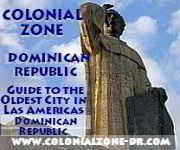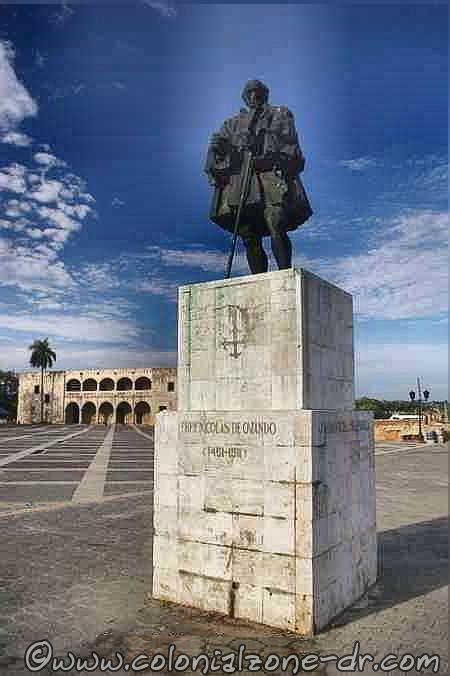If you found my web site useful consider making a donation through Pay Pal.
Thanks!

|
|


People Who Were Important in the History of Dominican Republic
Home | Dining & Night Life | Hotel | Sights | Pictures | Music | Colonial Zone Map | Hot Spots! Directory | Site Search
site map Copyright © 2005 - 2016 All Rights Reserved. Colonial Zone-Dominican Republic (DR)
Our complete exchange rate tool.
Home | Calendar | Night Life/Dining | Sight Seeing | Pictures | Businesses | Artists | Food | Helps | History | Language | Music | Media | Pastimes | Products | Tradition/Legend | Links | About Us | Buy Mamajuana | News Blog | DR Gringa's Life Blog | Dominican Dog Blog | Web Designer
[TOP]
History-Sights - People in Our History
Francisco de Bobadilla | Diego Columbus | Father Bartolomé de Las Casas | Sir Francis Drake | Juan Pablo Duarte | Las Hermanas Mirables / The Mirabal Sisters (The Hermansa Mirabal Museum, Home, Park and Monuments) | Fray Anton de Montesinos | Nicholas de Ovando | Francisco del Rosario Sánchez | Maria Trinidad Sanchez | Pedro Santana | Rafael Leonidas Trujillo Molina |
People in Our History
Some of the basic, condensed history of the people that made Dominican Republic. The good and the bad. All had a hand in making our island in the Caribbean what it has become today. The Tainos called the island Quisqueya. It has also been called, Hispanola, Las Americas, La Primera, Greater Antilles, and of course as we know it now, República Dominicana/ Dominican Republic. Read on to learn about the discoverers and founders of this beautiful land.
Nicholas de Ovando (1451-1511)
Frey Nicolás Ovando y Cáceres was born into a rich family in Spain. When there were too many complaints about Francisco de Bobadilla He replaced Bobadilla in 1502 becoming the third Governor and Captain-General of the Indies. He served as the Governor of Hispaniola between 1502 and 1509.
When he arrived to take over his post he brought with him over 30,000 colonists to populate the island. Ovando was a conquistador and in a very short time he exploited and enslaved the islands indigenous peoples exterminating whole towns (Slaughter of Jaragua and Higüey). He conquered and enslaved the native peoples for household uses, to plant crops including the introduction of sugar cane. He used them to mine for gold and even made them slaves on the ships returning to Spain.
One of the first terrible acts of Ovando when he became Governor was to order the arrest of Anacaona, a Taíno queen (you can see the image of Anacona in Plaza Colon climbing up the side of the Columbus statue). He had his army find her and while doing this he massacred many of the indigenous peoples. Anacaona was executed by hanging. After this happened many of the natives fled their island home.
+click image to enlarge Statue of Frey Nicolás Ovando located in Plaza España.
Ovandos type of governing was the model of the great conquering of Spain in the new world. He commissioned expeditions of discovery and conquest throughout the Caribbean from his offices here in Hispaniola. He founded 17 villages and cities and instituted the first town halls. Under Ovandos rule the Spanish colony of Santo Domingo became very rich but in acquiring the riches it cost the lives of most all of the original inhabitants.
Finally King Ferdinand V made the brutal Ovando return to Spain in 1509 to answer for his treatment of the native people. At this time Diego Columbus was appointed his successor as governor. Ovando returned to Spain a rich man as he was permitted to keep all the property and riches he acquired while exploiting the island and its native people.
The very large and elaborate home of Ovando is located on Calle las Damas (number 47 on the Colonial Zone map) and is now the Hostal Nicolás de Ovando.
Some of Ovandos accomplishments -
*Villa Nueva Isabela (now called Villa Duarte), the original settlement founded by Bartolomé Colón located on the other side of the Rio Ozama was hit by a major hurricane in 1502 and almost destroyed. Fray Nicolás de Ovando moved the settlement to the west bank of the Ozama River where Zona Colonial is now located.
*The governor built in the Ciudad Primada/ First City streets and buildings, such as the Convento de San Francisco/ Convent of San Francisco, Hospital de San Nicolás/ St. Nicholas Hospital, la Casa de La Moneda/ Casa de La Moneda, La Torre del Homenaje/ the Tower of Homage many beautiful private homes and also many streets including Calle del Rey/ King Street, later called Calle de las Damas.
*Even though Fray Nicolás de Ovando abused many during his short time as governor of Santo Domingo he is credited with building the city up giving it the charm and charisma it still has to this day.
*The Franciscan Monks arrived in 1502 under the command of Nicolas of Ovando started the construction of the the first monastery in the new world in 1508 El Monasterio de San Francisco which stands now in ruins.
Diego Columbus (Colón) (1480 - 1526)
The first born son of Christopher Columbus (Cristobal Colon), Diego, is thought to have been born in Lisbon or Porto Santo, Portugal. His mother, Felipa Perestrello e Moniz, died when he was 4 years old. From a very young age he had the opportunity to belong to the Spanish court as page of the prince Don Juan and after that the queen. According to the capitulations of Santa Fe, signed by Columbus and Catholic Kings, all the titles that were granted to his father Christopher, would be inherited by Diego, his son. But all these privileges were denied to him before and after the death of the Admiral.
When Diego married Maria de Toledo (María de Toledo y Rojas o María Álvarez de Toledo was the Granddaughter of the First Duke of Alba, Niece of the Second Duke of Alba, Cousin of King Ferdinand II of Aragón El Católico, and Great-Niece of the Catholic Kings) in 1508, her being of noble lineage who's family had much influence in the Spanish court, allowed Diego to obtain official recognition and thus granted him many privileges.
In 1509 Diego Columbus was named Governor of the Indies upon his arrival in Hispaniola to replace Nicholas de Ovando. Accompanied by its wife, uncles, their brother Fernando and a large following.

During the government of Diego Columbus after Hispaniola came the conquests of Cuba, Puerto Rico and Jamaica. As soon as he settled in the colony and built his residence The Columbus Palace/ Alcazar de Colon, Diego Columbus began to grant privileges to the people who came with him. For example, all were benefited with distribution and allotment of the Indians properties. This caused much discourse between some resident Spaniards of the island. They complained before the court and demanded a better treatment on the part of the Governor. It was then when the Treasurer, Miguel de Pasamonte, formed a group called The Servants of the King to oppose the governing group. In order to finish with the fight between both groups, the monarch named the Real Audience, a court that reduced the powers of the governor.
Another one of the disadvantages that confronted the Governor was the fight of the Dominican priests defending the Indians. The defense of the Indians was initiated by Fray Antón de Montecinos, with the sermon that demanded a better treatment for the natives. The speach of Montesinos was listened to by the governor and the other authorities, and was pronounced in 1511. He was made Viceroy of the Indies in May 1511, remaining in charge until 1518.
The conflicts in Hispaniola forced the king to replace Diego Columbus, who returned to Spain. After being in Spain for a few years he gained favor of the king who again named him governor in 1520. Two years later the first rise of the black slaves took place. This new government was calmer than the previous one but still King Carlos V finally suspended the son of Christopher Columbus from the government of Hispaniola.
Columbus returned to Spain in 1523 and died in 1526 without the promised recognition of the inherited rights promised him by his father Cristobal.
Francisco de Bobadilla
Born in Spain he was nobleman who served fighting against the Moors when Spain retook their country. Francisco de Bobadilla, Chevalier and Knight. Commander of the Royal Order of Calatrava. Because of this he was favored by the royal family King Ferdinand and Queen Isabella appointed him to succeed Diego Columbus in 1499 as the second governor of the Indies. He was also to check up on the Columbus boys, Cristóbal Colón (Christopher Columbus) who was the governor of the island at this time, ruled along with his brother, Bartholomew and Giacomo (also called Diego). Because of the rebellion of Roldán and the many complaints the Queen was hearing Bobadilla was sent to. check out what was happening first hand
Bobadilla arrived in the colonies in 1500 to take over. Upon finding out what the brothers Columbus were really up to Bobadilla took it upon himself and had Columbus and his brothers captured, confiscated all their goods and belongings, and had all sent back to Spain, the men in chains. This made the queen angry because she didn't order these actions. So in 1502 he was replaced as governor of Hispaniola by Nicolás de Ovando y Cáceres. The Queen sent for Bobadilla to return immediately to answer to her.

The second governor of the colony died July 11, 1502 during a hurricane in the Mona Passage while returning to Spain. The storm wrecked most of the ships, including the one he was on, in the 31-ship convoy.
Some interesting items:
*It is thought that Columbus had an affair with Bobadillas' niece, Eleanora de Bobadilla, who was married to Alfonso de Lugo, Governor of all the Canary Islands. This is where Columbus made stops to restock his supplies whilst sailing the islands)
Pedro Santana who also held the Spanish noble name Marquess de las Carreras, was a key figure in driving the Haitian occupation out of Dominican Republic. He was president during the terms from 1844-1848 and again during 1853-1856, and last from 1858-1861. After this he also held the post of Governor and Captain General of the territory until 1862.
He was a strong military leader and dictator during his reign. He wanted Spain to annex República Dominicana, which the Trinitarians did not like. He fought, arrested and killed anyone that stood in his way. The people who fought along side him to give the country independence now were enemies. He was the person who had exiled Duarte and also exiled and arrested the members of La Trinitaria. He had María Trinidad Sánchez (the sister of Francisco del Rosario Sánchez), the co-creator of the Dominican flag along with Concepción Bona, captured. Santana had Maria tortured relentlessly trying to get information about the conspirators and La Trinitaria who were against him. She gave up no information and she was put to death one year after the proclamation of Independence (February 27, 1845). She was the first female martyr of Dominican Republic.
Pedro Santana died in Santo Domingo on July 16, 1864, and was buried in the Fortelaza Ozama next to the Torre del Homenaje.The Congress of the Dominican Republic awarded him the title of "Liberator of the Nation" on July 18, 1849 for his victory in the Batalla de las Carreras.



Custom Search




